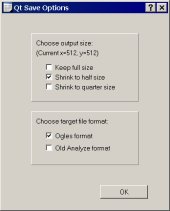
  |
||||||

|
||||||
| Simple | 
|
|||||
| Dicom | ||||||
| Reader | ||||||
| by Johannes A. Koeppen | ||||||
| Home | ||
| Screenshots | ||
| Installation | ||
| Usage | ||
| Download | ||
| To be used for: OGLES |
||
| The Simple Dicom Reader (SDR) can be controlled by a graphical user interface only. It does not accept any program arguments. | ||||||
| Preparation | ||||||
|
SDR expects to read an ordered and equidistant series of DICOM images. Within a series of images SDR will not accept different matrix seizes, images from different series, and scouts. |
||||||
|
|
||||||
| Suggested Usage | ||||||
|
When started, SDR assumes that a new volume should be created. |
||||||
| To add one or many DICOM slices to that volume you might either: Use the 'File->Add File(s) to Volume' menu item. |
||||||
|
||||||
| or: Use the Dicom preview tool ('Tools -> View Directory'). You might want to double click the left mouse button over a Dicom icon to set the windowing. |
||||||
|
||||||
|
|
||||||
| top |
||||||
| Before a series is opened, SDR asks whether the new volume file should contain byte or integer data. |
||||||
| If byte data was selected, SDR presents a windowing dialog. Some scanners won't save slices with file names reflecting acquisition time. Unfortunately this condition will be perceivable only when (pre-)viewing the data volume. In that case it is advisable to reorder the directory by 'Tools -> Reorder Directory'. The 'Reorder Directory' routine attempts to create an 'ordered' subdirectory with Dicom file names, reflecting slice positions from Dicom header information. |
||||||
|
|
||||||
| top |
||||||
| Some
header information is provided in the main window. This information
might be helpful for debugging. |
||||||
 |
||||||
|
|
||||||
| top |
||||||
| Before saving the volume SDR asks for format information. |
||||||
 |
||||||
|
|
||||||
| top |
||||||
| For
example in diffusion tensor imaging it is desirable to modulate one
image series with the information from another series. The 'Viewer and
Merger' provides a simplistic implementation of this modulation for old
Analyze files. |
||||||
 |
||||||
|
|
||||||
| top |
||||||
June 30, 2007, Johannes A. Koeppen, koeppen@neuranse.com



